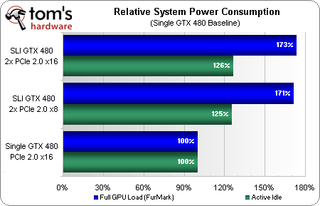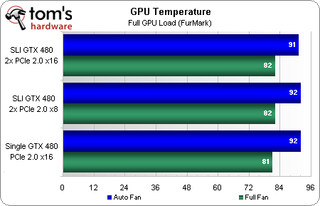PCI Express And SLI Scaling: How Many Lanes Do You Need?
Are the most elaborate platforms really required to host the fastest GPUs, or can you get away with P55's lane-splitting scheme? As Nvidia’s latest graphics processors push 3D performance to new heights, we examine the interfaces needed to support them.
SLI Scaling Summary
Our list of SLI-based benchmarks showed excellent scaling, but only at the highest-tested 2560x1600 resolution. A serious CPU “bottleneck” is the most likely cause for decreased SLI scaling at lower resolutions. For most games, it doesn’t even make sense to test a pair of GeForce GTX 480 graphics cards at anything less than 2560x1600, and one benchmark was completely crippled by the performance of our 4.00 GHz CPU, even at 1920x1200. Let’s see what effect this CPU limit had on our overall scaling performance:

While two cards outperform a single card by up to 90% in most games, that only happened at our highest test resolution. Poor scaling at lower resolutions dropped our average gain to only 63%. Moreover, the one game that was most bandwidth-dependent in our single-card tests was the same game that became almost completely CPU-bound in SLI, obliterating the 8% performance difference previously noted in our single-card PCIe evaluation.

While the performance gain of SLI exceeded the increased power consumption of today’s system, we again note that it happened only at high resolutions. A net loss in SLI power efficiency can be attributed exclusively to the inclusion of 1680x1050 in today’s tests.

One other peculiarity of today’s test was that our x8/x8 SLI configuration required the card coolers to be adjacent to each other, while the x16/x16 configuration had one empty space between cards. Yet, we never saw a card overheat. How much of a problem did shoving the cards together create?

Nvidia puts a hole in the back of its GTX 480 graphics card, behind the fan, so that the fan can take air in from both sides. The result is that we didn’t see a big difference in temperature between cards that were placed closer together. We expect this design to be less effective for the center card in three-way configurations, and we plan to scale our tests to even greater heights in future articles.
Stay on the Cutting Edge
Join the experts who read Tom's Hardware for the inside track on enthusiast PC tech news — and have for over 25 years. We'll send breaking news and in-depth reviews of CPUs, GPUs, AI, maker hardware and more straight to your inbox.
Current page: SLI Scaling Summary
Prev Page SLI Scaling: S.T.A.L.K.E.R.: Call Of Pripyat Next Page Conclusion-
amk09 I love how people always bash on x8 x8 and how it sucks, when in reality x16 x16 is only 4% better.Reply
You spend unnecessary $$$ on a x58 platform while I save money that I can put towards a GPU upgrade with my p55 platform :) -
carlhenry i'm curious how other games are "dependent" on bandwidth while others are not... does that mean that the games that aren't dependent on bandwidth isn't using the full potential given the the size advantage of x16 over the x8? i wish every game would utilize every inch of your hardware in the future.Reply -
sambadagio For all your fps hunters, I bet you only have a screen at home with 50 or 60Hz. So just for your information, everything above 50 or 60fps is just useless... In this aspect, a PCIx 4x is actually enough... ;-)Reply
-
luke904 so a 4850 crossfire setup will hardly be bottlenecked by an 8 lane motherboard.Reply
anyone know if 4850's are going to be unavailable any time soon? You could get the 3000 series for quite awhile after the 4000's released so I'm crossing my fingers until i can afford a cpu upgrade and another 4850
cpu is currently a 7750BE and so im pretty sure it would bottleneck the 4850's. I think it does with just one actually. -
jgv115 @ carlhenryReply
It's not the game's fault. The GPU can only go as fast as it was made to go. So in simple terms you could say that GPUs these days aren't "fast" enough to use all the bandwidth PCI Express offers. -
outlw6669 Very nice review but I have to ask, why did you not test with 5970's?Reply
On a card for card basis they are still quite a bit more powerful than the GTX 480 and should require the most bandwidth of any current card for maximum performance. -
barmaley This review tells me that if you already have an i7 and at least 2xPCIe 16x lanes on your motherboard then in order to play modern games, all you are going to be upgrading for the next several years is your graphics.Reply -
Aionism Even though I'm not interested in SLI I am glad to finally see a benchmark comparing PCI-E x16 and x4. My motherboard only allows me to use my video card in my x4 slot for some reason. I've been wondering how much performance I've been losing over that.Reply
Most Popular


